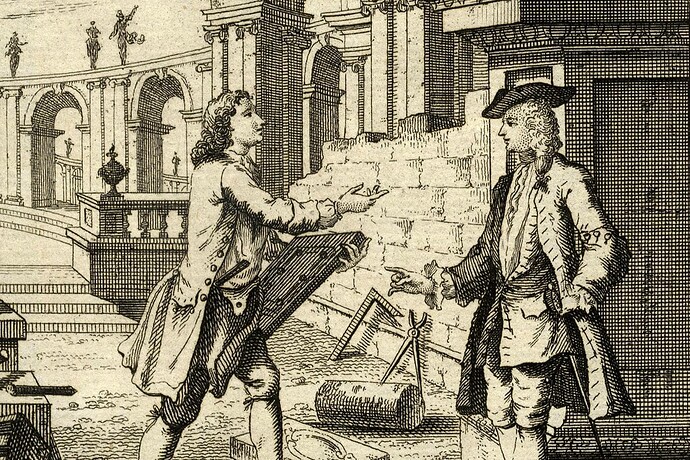“Standing on the defensive indicates insufficient strength; attacking, a superabundance of strength.”
From “The Art of War”, by Sun Tzu, 5th Century B.C.

(Julius “Dr. J.” Erving’s with his “rock the cradle" dunk, “the greatest dunk in history”, over the Los Angeles Lakers’ Michael Cooper in 1983)
“Hey, Wang! What’s with the pictures? It’s a parking lot. Come on!”
Rodney Dangerfield as Al Czervick from “Caddyshack”, written by Brian Doyle-Murray, Harold Ramis and Douglas Kenney, 1980
This is going to be inserted in my “Chinese Origin of Freemasonry” article.
“In Japan, it was said that sacrificing a woman at a rushing river would placate the spirit who lived there, allowing for the construction of bridges and the safe passage of boats.”
From "The ‘darker link’ between ancient human sacrifice and our modern world", by Sarah Kaplan, U.K. Independent, April 5, 2016
“Giving up young fellows and ladies to waterway divinities (suffocating them) and covering slaves alive when their proprietors when their proprietor passed on was in vogue amid the Shang and Zhou Dynasties.”
From “Human Sacrifices at the Temple of Heaven” by Ainsley, on medium.com, May 4, 2019
THE DATA
From 1766 B.C. to 1122 B.C., the Chinese Shang Dynasty continuously performed human sacrifices. Medium.com’s Ainsley described them as “people being yielded”.
The human sacrifice temple at Huanbei where the Shang Dynasty’s royal family lived is riddled with bodies of victims. Medium.com’s Ainsley described it as a “substantial number of relinquished people”.
Human sacrifice remains are found throughout the Shang’s Lou Yang City. Medium.com’s Ainsley referred to them as “conciliatory remains”.
The Shang developed a tanged hatchet known as the Yueh specifically for the purposes of human sacrifice. Medium.com’s Ainsley referred to it as "putting human forfeits out of their wretchedness".
The Shang and Zhou Dynasties both sacrificed boys and girls to human-salamander hybrids by suffocating them. Medium.com’s Ainsley said that the practice was "in vogue", and referred to them as “young fellows and ladies”.
The Shang buried slaves alive when their owners passed on. Medium.com’s Ainsley lovingly described it as “covering” them.
From 1046 B.C. to 256 B.C., during the Zhou dynasty, human sacrifice and cannibalism spread from the exclusive pleasure of the ruling dynasty to the general populace. Medium.com’s Ainsley brazenly lied that it was “on the disappear”, and that the Zhou were “more humanistic”. They also said that the Zhou merely “rehearsed” it, and called it “human penance”, where “penance” clearly implies that the victims deserved it.
From 221 B.C. to 206 B.C., Qin Shi Huang ruled as China’s first emperor. Upon his death, he had at least 8,000 of his soldiers memorialized in terra cotta, then beheaded, burned in a circular human sacrifice oven, and eaten. Then the terra cotta replicas were buried with him in his tomb. Medium.com’s Ainsley omitted the number, and called it simply “an armed force”, and said that they hadn’t been sacrificed, at all.
Qin Shi Huang had a large number of specialists and officers sacrificed and buried with him in the tomb. Medium.com’s Ainsley referred to them as “forfeits” and “bodies.”
Burying human sacrifice victims alive in tombs was standard procedure during the Qin Dynasty, notably at the Fenyang tomb. Medium.com’s Ainsley called the human sacrifice victims “unfortunate casualties”, and lovingly referred to their being buried alive as “covered”.
From 206 B.C. to 25 A.D., during the Han dyansty, human sacrifice and cannibalism were still commonplace. Fantastically, medium.com said “human penance was still generally polished.”
Where “penance” clearly implies that the victims deserved it, and that the perpetrators were “polished” or sophitisticated. The Coincidence theorist will reject it with “oh, but that’s just autocorrect!”
From 1368 to 1420 A.D., the Ming Dynasty briefly formally stopped the practices of human sacrifice and cannibalism in China.
In 1420 A.D., the circular, Satanic-green tile human sacrifice oven known as “the pit of hair and blood” was built at the “Temple of Heaven” in Beijing. It’s revered as a “cultural treasure” by the godless Communist Red Chinese to this day.
Medium.com’s Ainsley described it as “uncommon”, and referred to it, variously, as a “broiler”, a “stove”, and a “harmless looking oven”. Yum!
Say what you will about our literally-blood-drinking Illuminist friends, it’s not like they’re not right up-front about what they’re doing, and what they’re into.
“The pit of hair and blood”, ah, mirth. “Hey, Wang, run down to the pit of hair and blood and grab me some lunch for tomorrow!”
That’s a Caddyshack reference, by the way.
From 1420 A.D. to 1720 A.D., the human sacrifice oven known as the pit of hair and blood was in continuous operation, at least to the expansion of the “Circular Mound Altar”.
From 1420 A.D. to 1464 A.D., human sacrifice and cannibalism were once again the official State religion of China.
In 1530 A.D., the Chinese built the “Circular Mound Altar” next to the “pit of blood and hair”. The Circular Mound Altar is a gigantic pile of human sacrifice victims.
In 1720 A.D., the Chinese expanded the “Circular Mound Altar” which they’d built in 1530 A.D.
If you think that the bloodline ruling China has changed, or that their ancient religious practices have changed, one iota, there’s a bridge for sale in Brooklyn that I think it would profit you to look at.
In 1773, prominent generational Satanist Freemason Captain James Cook attended a human sacrifice and cannibalism ritual on Tahiti.
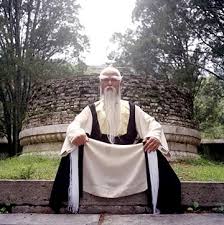
(Pai Mei, brazenly sitting in front of a circular human sacrifice oven in “Kill Bill, Volume 1”, 2003. 33rd Degree Freemason Quentin Tarantino figured that the rubes would never notice.)
THE ARTICLES
On April 5, 2016, the U.K.'s Independent said “The ‘darker link’ between ancient human sacrifice and our modern world”.
Where author Sarah Kaplan walked the dark link back to merely “darker”, and put “darker link” into quotation marks, to call it into question.
The article goes on to say “In Japan, it was said that sacrificing a woman at a rushing river would placate the spirit who lived there, allowing for the construction of bridges and the safe passage of boats.”
This is signal, in that it clearly identifies the human sacrifice to the human-salamander hybrid dwelling in the river there.
On May 4, 2019, medium.com published “Human Sacrifices at the Temple of Heaven”.
Where, under the false guise of familiarity, author “ainsley ains-ley” omitted the word China, to make it unsearchable. That’s an example of the propaganda technique known as “compartmentalization”.
The article that documents human sacrifices the Temple of Heaven in Beijing, China goes on to question: "Were Human Sacrifices Made at the Temple of Heaven in Beijing?"
Where, under the false guise of familiarity, author “ainsley ains-ley” once again omitted the word China, to make it unsearchable. That’s an example of the propaganda technique known as “compartmentalization”.
The words “mystery”, “baffled” and “puzzled” are memes, used, among numerous similar variants, whenever anyone in the wholly-controlled-and-coopted Political, Academic, Scientific and Media establishments wants to lie about, well, basically anything.
That’s wny the article goes on to say “Likely. I can’t state without a doubt however history, references and structures in the Temple of Heaven show that they were made.”
Where “show that they were made” walks it back a step from their actually being made.
The article goes on to say:
"Livraison de matériel de culture
Initial a little back ground on the Temple of Heaven. There are three primary structures in the Temple of Heaven, the Circular Mound Alter, the Imperial Vault of Heaven and the Hall of Prayers for Good Harvest. The Circular Mount Alter comprises of two regions, an inward round territory encompassed by an external square divider. There are a few minor structures in the external square region. One of these structures is a round green tiled broiler. A broiler obviously utilized for…. here it comes…… “human penances”. By this blameless looking stove is a pit called “the Pit of Hair and Blood”.
Where the author referred to a human sacrifice oven as a “broiler”, and referred to human sacrifices as “penance”, which clearly states that the victims deserved it.
It’s an example of what is known as “Black magic” or “neurolinguistic programming”. I’m breaking the spell with the White magic of truth.
The article goes on to say, at some length:
"Human Sacrificial History in China
Shang Dynasty — 1766 BC and 1122 BC Also known as the Yin Dynasty managed a huge piece of China for just shy of 650 years between 1766 BC and 1122 BC. Amid this period China was a slave society where slaves, non slaves, creatures and whatever else alive (and dead) made enticing penances. Here are a few instances of people being yielded amid the Shang Dynasty."
From 1766 B.C. to 1122 B.C., the Chinese Shang Dynasty avidly performed human sacrifices. Medium.com’s Ainsley described them as “people being yielded”.
The article goes on to say:
"Human and creature conciliatory remains were found in Lou Yang city that dated back 2,700 years.
Analysts exhumed a multi year old Shang Dynasty royal residence cum temple complex in the old city of Huanbei. The complex had been deprived of merchandise at that point consumed to the ground following 50 years of utilization. Substantial number of relinquished people were found in the complex."
The human sacrifice temple where the Shang Dynasty’s royal family lived is riddled with bodies of victims. Medium.com’s Ainsley described it as a “substantial number of relinquished people”.
Mm, substantial, how impressive!
Human sacrifice remains are found throughout the Shang’s Lou Yang City. Medium.com’s Ainsley referred to them as “conciliatory remains”.
The article prattles on:
“The Shang may have been really straightforward about relinquishing people in the first place yet they were not ease back to build up a dimension of refinement. They built up a tanged hatchet considered the Yueh that was at first utilized as a weapon then later turned into the formal weapon used to put human forfeits out of their wretchedness.”
Here’s a photo of the Yueh, or Yueh human sacrifice axe used to behead victims:

(Shang Dynasty “Yueh” human sacrifice axe head, 1,700 B.C.)
That’s from 1,700 B.C. Now, compare that grinning god of death to the Tahitian “Tiki”:
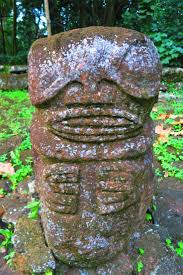
(“Tiki” human sacrifice idol, Tahiti)
It’s the toothed mouth that makes it irrefutable.
Here’s prominent generational Satanist Freemason Captain James Cook at a human sacrifice and cannibalism ritual on Tahiti in 1773:
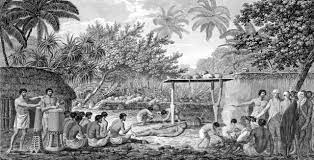
(James Cook being treated to a human sacrifice cannibalism feast on Tahiti in 1773)
I’m a badass, in that I stated that Cook was a Freemason prior to researching it.
Then I went to hawaiifreemason.org and learned “Some accounts of Freemasonry in Hawaii have recorded that Captain James Cook, considered by many to be the greatest Pacific explorer and navigator, and the first to discover the Hawaiian Islands, was a Freemason.”
Now here’s a painting of Cook, making a purportedly-secret Masonic “gesture of recognition” with his left hand:

(Captain James Cook, using his left hand to make a purportedly-secret Masonic “gesture of recognition” with his left hand)
And, now, for any Coincidence theorists lingering in the readership, here’s an 18th Century engraving from the frontispiece of The Builder’s Dictionary, 1734 (©Museum of Freemasonry, London), where the generational Satanist Freemason on the left is using the same purportedly-secret “gesture of recognition” that James Cook is in the photo immediately above:
(18th Century from frontispiece of The Builder’s Dictionary, 1734 ©Museum of Freemasonry, London), where the generational Satanist Freemason on the left is using the same purportedly-secret “gesture of recognition” that James Cook is in the photo immediately above)
In the image immediately above, the Scottish Rite Freemason on the right is using a gesture of recognition that means that he wants to “rock on”, or “Hail, Satan!”, depending upon one’s perspective. I’m afraid that, given the historical context, we’re going to have to throw out “support for the Texas Lonhorns football team” or saying “I love you” in American Sign Language.
They’re both using conscious deception while retaining the firmness of purpose that goes with complete honesty.
Did you notice how Cook is off-center to the left in the frame of the painting to give prominence to his left eye? That’s because, to followers of the Left-hand path, the left eye is the “eye of Will” or the “eye of Horus”.
But don’t take my word for it:
‘The right eye is the Eye of Ra and the left is the Eye of Horus’.”
From “Freemasonry - Religion And Belief - The 3rd Temple”
Facebook: “Welcome to the Left-Hand-Path-Network, where Satanism is not about worship, but it’s study.”
I have included these pictures so that you could get a better idea of what a generational Satanist Freemasons from the 18th Century looked like.
They figured that the rubes would never notice the coded visual imagery.
They are all related to one another through the maternal bloodline. They comprise between twenty and thirty percent of the populace, and are hiding in plain sight in every city, town and village on Earth. It’s how the few have controlled the many all the way back to Babylon, and before.
But they say that the hardest part of solving a problem is recognizing that you have one.
Don Croft used to say “Parasites fear exposure above all else”.
But let’s get back to the Medium.com article. As I was saying, the Shang and Zhou Dynasties both sacrificed boys and girls to human-salamander hybrids by suffocating them. Medium.com’s Ainsley said that the practice was "in vogue" , and referred to them as "young fellows and ladies ".
The Shang developed a tanged hatchet known as the Yueh specifically for the purposes of human sacrifice. Medium.com’s Ainsley referred to it as "putting human forfeits out of their wretchedness".
The next paragraph is a blockbuster:
“Giving up young fellows and ladies to waterway divinities (suffocating them) and covering slaves alive when their proprietors when their proprietor passed on was in vogue amid the Shang and Zhou Dynasties.”
The Shang and Zhou Dynasties both sacrificed boys and girls to human-salamander hybrids by suffocating them. Medium.com’s Ainsley said that the practice was "in vogue", and referred to them as “young fellows and ladies”.
The Shang buried slaves alive when their owners passed on. Medium.com’s Ainsley lovingly described it as “covering” them.
The article goes on to say:
“Zhou Dynasty — 1046 BC to 256 BC. Not to be beaten by the Shang Dynasty, the Zhou line created both creature and human penance to their precursors or divinities as a standard piece of Chinese culture. Wager that is one piece of Chinese culture your Chinese companions won’t boast out. Penances where said to be frequently made to favor houses amid this time. Reconsider next time you are welcome to the gift of a Chinese home!”
From 1046 B.C. to 256 B.C. human sacrifice had spread from the exclusive pleasure of the ruling dynasty to the general populace. Medium.com’s Ainsley called it “human penance”, where “penance” clearly implies that the victims deserved it.
The article goes on to say:
"The Zhou Dynasty is viewed by students of history as been more humanistic than the Shang Dynasty since human penances were on the “disappear”. Consistent with structure however, human penance was rehearsed for the entire Zhou Dynasty.
The article goes on to say:
“Qin Dynasty — 221 BC to 206 BC. Not one to break point of reference, the principal Emperor had his tomb given the yielded bodies of specialists and officers. Actually I’m exceptionally appreciative he didn’t pay attention to human forfeits as well and made a Terracotta armed force to stay with him in eternity rather a cluster of dead folks that would not make an amazing vacation destination 2,200 years after the fact.”
Here, Ainsley has lied hugely and brazenly that the humans in the terra cotta army were not each individually beheaded with a Yueh, cooked in a circular human sacrifice oven, and eaten.
Did you notice how Medium.com’s Ainsley devilishly omitted the name of the emperor, and called him merely “principal Emperor”? That’s an example of the propaganda technique known as “compartmentalization”.
For the record, it’s Qin Shi Huang, the first emperor of China.
From 221 B.C. to 206 B.C., Qin Shi Huang ruled as China’s first emperor. Upon his death, he had at least 8,000 of his soldiers memorialized in terra cotta, then beheaded, burned in a circular human sacrifice oven, and eaten. Then the terra cotta replicas were buried with him in his tomb. Medium.com’s Ainsley omitted the number, and called it simply “an armed force”, and said that it hadn’t been sacrificed, at all.
Qin Shi Huang had a large number of specialists and officers sacrificed and buried with him in the tomb. Medium.com’s Ainsley referred to them as “forfeits” and “bodies.”
Here’s a picture of some of the soldiers who were recreated in terra cotta, then beheaded, cooked and eaten:
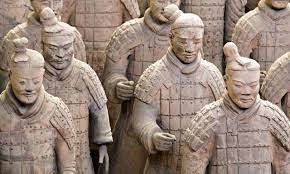
(Terra cotta army", 206 B.C.)
The article goes on to say:
“Different tombs, outstandingly the Fengyang tomb from the Qin Dynasty were additionally found with human penances where the unfortunate casualties were covered alive.”
Burying human sacrifice victims alive in tombs was standard procedure during the Qin Dynasty, notably at the Fenyang tomb. Medium.com’s Ainsley called the human sacrifice victims “unfortunately casualties”, and referred to their being buried alive as “covered”.
The article goes on to say:
“Han Dynasty — 206 BC to-25 CE. Antiques, for example, a bronze vessel show that human penance was still generally polished.”
From 206 B.C. to 25 A.D., during the Han dyansty, human sacrifice and cannibalism were still commonplace. Fantastically, medium.com said “human penance was still generally polished.”
Where “penance” clearly implies that the victims deserved it, and that the perpetrators were “polished” or sophitisticated.
The article goes on to say “Ming Dynasty — 1368 to 1644. Human penances left style for some time and by Emperor Hong Wu in 1395. His child passed on so to of the sovereigns mistresses where relinquished to stay with him. In 1464 Emperor Zhengtong denied the act of human penances.”
Since we know that the human sacrifice oven known as the “pit of hair and blood” was built in 1420 A.D., and is carefully preserved by the Godless Communist Red Chinese as a cultural treasure to this day, we can at best state that, from 1368 to 1420 A.D., the Ming Dynasty briefly formally stopped the practices of human sacrifice and cannibalism in China.
From 1420 A.D. to 1464 A.D., human sacrifice and cannibalism were once again the official State religion of China.
The article goes on to say:
“Qing or Manchu Dynasty — 1644 to 1912. Human penances returned into style AGAIN (helps me to remember the mullet and styles) just to be prohibited AGAIN by Emporer Kangxi in 1464.”
The words “mystery”, “baffled” and “puzzled” are memes, used, among numerous similar variants, whenever anyone in the wholly-controlled-and-coopted Political, Academic, Scientific and Media establishments wants to lie about, well, basically anything. One of those variants is “strange”.
That’s why the article goes on to say “Finish of Human Sacrifice and the Temple of Heaven - Strangely the Temple of Heaven was finished in 1420 which leaves 44 years amid the Qing Dynasty for it to be utilized for human penance.”
Where medium.com’s Intelligence operative Ainsley used “human penance” as a hedge against the plainspoken “human sacrifice”. As if somehow they deserved it. This is, unfortunately, an example of what is known as “Black magic”. Ainsley and the rest of their rotten ilk proudly refer to it as “tradecraft”.
The article goes on to say:
"Back to the implicating green tiled broiler and pit of blood and hair. I couldn’t locate any immediate connections between human penance and the Temple of Heaven BUT there is one condemning reference that surfaces in so much the travel industry writing. That reference is
In the southeast corner, pine and cypress branches were singed in the green-tiled broiler to respect the divine beings from paradise. To say goodbye to the divine beings, human penances were scorched in the stove. Beside the broiler is an uncommon pit called the Pit of Hair and Blood on the grounds that the hair and blood of the conciliatory unfortunate casualties were covered here."
Where, bravely, Ainsley has, in journalistic parlance, “buried” the grim truth to the very last paragraph of the article. If seventy percent of readers only read the headlines, what percentage do you think make it to that last paragraph?
Ainsley has referred to the enormous, Satanic-green human sacrifice oven as “uncommon”.
In 1420, the Chinese began burning human sacrifice victims alive in “the Pit of Hair and Blood”, a round, green-tiled oven at the Temple of Heaven in Beijing, China. Medium.com’s Ainsley Ains_ley referred to it as “uncommon”, and said “human penances were scorched in the stove”.
Where they’ve described human sacrifices as “penances”.
And where they’ve described being burned alive as “scorched”.
And where, lastly, they’ve described the human sacrifice oven as a “broiler” and a “stove”.
Here’s a picture of it:

(The “pit of hair and blood”, a human sacrifice oven in Satanic green tile, 1420 A.D., at the “Temple of Heaven” in Beijing)
A current article on mybeijingchina.com says "The Circular Mound Altar, which was built in 1530 and enlarged in 1740. There are two walls walls that encircle the altar. Both walls are painted red and surrounded by blue tiles. The Circular Mound AltarEach wall represents something different. The round inner wall represents heaven while the square outer wall represents earth.
After the Emperor signed the declaration that would be read to heaven outside the square wall, he proceeded to the terrace.
In the southeast corner, pine and cypress branches were burned in the green-tiled oven to welcome the gods from heaven. To bid farewell to the gods, human sacrifices were burned in the oven. Next to the oven is a special pit called the Pit of Hair and Blood because the hair and blood of the sacrificial victims were buried here."
This clearly shows how human sacrifice oven known as the pit of hair and blood was in continuous operation from 1420 A.D. to 1740 A.D., when the Circular Mound Altar was expanded. It was expanded because it’s filled with human sacrifice victims.
Here’s a picture of it:

(“Circular Mound Altar” filled with human sacrifice victims, Temple of Heaven, Beijing, 1530 A.D.)
In 1530 A.D., the Chinese built the “Circular Mound Altar” at the Temple of Heaven in Beijing. It is a gigantic mound filled with human sacrifice victims.
In 1740 A.D., the Chinese expanded the "Circular Mound Altar with exponentially more bodies of human sacrifice victims.
How long do you think that these people have left in power, now?
Please consider doing what you can to help speed the process.
Jeff Miller, Libertyville, IL, March 9, 2022
If you’d like to be added to this free mailing list, or know someone who would be, please send me a note at [email protected]
